![]()
![]()
![]()
Use LEFT and RIGHT arrow keys to navigate between flashcards;
Use UP and DOWN arrow keys to flip the card;
H to show hint;
A reads text to speech;
6 Cards in this Set
- Front
- Back
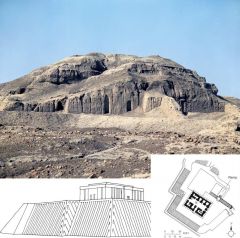
#12 White Temple and its Ziggurat Uruk (modern Warka), Iran Sumerian 3,500 - 3,000 B.C.E. _______________________ Content: Only the ziggurat (platform) still stands today. The temple once stood on top of it. The ziggurat still retains its dense structure and few passgeways. It is known from the remains of the ziggurat that it did not have many rooms or windows. _____________________ Style: The construction was designed to elevate the temple above the rest of the city. Both the temple and its ziggurat were constructed out of mud brick, mortar, and sealed with tar. The temple at the top was thought to have been white washed in its time using mineral paint. The Ziggurat also includes the remintes of diagonal stairways. |
Context: The basic design and service of the temple was for religious purposes. By raising the temple above the ground, the Sumerians thought it brought them closer to the God's they believed governed over their lives: a concept that lived on in later societies. This society was the first to develop the concept that gods lived in a space above the human world. The temple at the top was thought to be similar to the ones discovered in other ancient, near eastern cities. This meant it was small enough to entertain a select number of religious preists and attendents but no larger. The temple contained a small room called the cella and a divinity room behind that. The temples, since they were built up towards the gods, were considered "waiting rooms" for the gods to descend to and from earth. Thus, temples held statues of the gods and food sacrafices in their honor. |
|
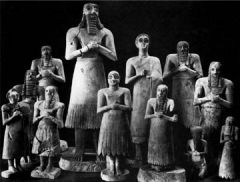
#14 Statues of votive figures, from the Square Temple at Eshunna modern Tell Asmar, Iraq Sumerian 2,700 B.C.E. _______________________ Content: These are gypsum carved, human statuettes that have been found in abundance in various Sumerian temples. They also have inlays of shell and black limestone. They are praying figures with enormous, stylized eyes and are found in many sizes. Some of the statues are children figures as well. _______________________ Style: Besides the eyes, there are other stylized features of these statues, like their body shapes and faces. The facial features are also more individualized and representative of certain humans rather than just a generalization of what humans look like. All of the figures are subtractivly carved and are meant to be seen from the front as there is no detailing on the backs. |
Context: These "votive" figureens give insight into the Sumerian religious rituals and beliefs that they were a part of. These statues were patronized or purchased by citizens hoping to look good in the eyes of the gods. The patrons would have the statues made in their likeness and placed in the "cella" of the temples so they could witness and been seen by the gods passing between heaven and earth. This was one of the reasons the figures had such big eyes, it was supposed to represent the patron's worship, awe, and receptivity of the gods. There placement in temple alters or something similar explains their decorative fronts and blank backs, they were meat to be placed in temples, and not moved, facing the area where the gods would come. Also, the different sizes of the figures did not also represent actual diversity among humans, instead it represented a hierarchal scale. More important and more wealthy patrons could purchase larger and more expensive stones to be carved and signify their importance. It was another step towards honoring the individual and their accomplishments, even if it was just bragging material to the gods. |
|
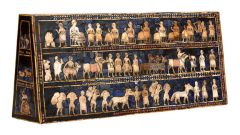
#16 The Standard of Ur from the Royal Tombs at Ur modern Tell el-Muqayyar, Iraq Sumerian 2,600 - 2,400 B.C.E. _______________________Content: The standard is a wooden box with lapis-lazuli inlays on all sides. There are mosaics coverings the surface made of lapis-lzuli and shell depicting scenes of royalty, war, peace, and snippets of the Sumerian's technological ingenuity and celebratory occasions. _______________________ Style: All the figures are stylized and in twisted perspective, with the horizontal registers acting as grounds for the figures to walk on. The registers also organize the piece into themed sections: War and Peace. The pieces of mosaic shell are carved with a subtractive technique to create generalized features for the human figures, animals, and objects. The dress of the figures (or on the Panel of War: lack thereof) is what mainly differentiates them. |
Context: The city of Ur was a center of Sumerian culture, economy, wealth, power, and sophistication of civilization that dominated much of the near east. The presence of lapis-lazuli speaks to the trade that the Sumerians established for semi-presious stones and metals like lapis-lazuli. Sumerians were able to trade industrially with places like India and Afghanistan. Since lapis-lazuli is rare and holds a dark, rich blue color, it has been a prized stone throughout history, including in the Sumerian culture. The stone was used only for significant, decorative purposes. It's use here in the Standard of Ur indicates that the piece was of great importance. Hence, the images it depicts must be of equal importance. There are two panels on either side: the Panel of War and the Panel of Peace. They both utilize horizontal registers to organize and separate the different parts of the events depicted. The top register is also seemingly the more importance, always holding the image of the king. On the Panel of War, the king is positioned in the center of the top panel and is so large that his head breaks the border around the image. This enlargement of the king illustrates the culture's need to focus attention on their royalty. The king appears taller on the Panel of Peace as well. The repetition of this speaks to intentional hierarchal imagery in the piece. On the middle section of the Panel of War, there are Sumerian soldiers dressed in garb and helmets herding naked prisoners of war. The prisoners were depicted nude becuase it was symbolic and related to the Mesopotamia idea that nudity is related to death. On the bottom register, the chariots and the animals pulling evolve as the eye moves from left to right. They start standing and eventually end up running. This was done to create movement, action, and speed through the changing positions of the animals. On the Panel of Peace side, there is a banquet with the king is sitting high on his stool and faced by six figures holding their cups up as a lyricist and supposed singer surround the scene. Below that section is one of people bringing food and then in the last section, there are people toting sacks and leading animals. This side is representative of how the Sumerians celebrated and also the different classes of people and their importance. The stylized, abstract figures speak to portray the importance of depicting the events rather than the individuals. The outline of the Standard of Ur is also similar to the way which Sumerian written language, "cuneiform", was laid out to be read. Cuneiform actually comes along not too long after this piece is created, meaning the layout of the standard was transitional from picture stories to a written language. |
|
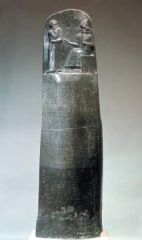
#19 The Code of Hammurabi Babylon, moder Iraq Susian 1,792 - 1,750 B.C.E. _______________________ Content: This is a basalt stone stella carved with written inscriptions and a top carving of Hammurabi in the presence of a "fire-shoulder" god. _______________________ Style: The writing is lightly chiseled into the stone whereas the scene of Hammurabi is subtractive and in high relief. The stone is also a dense material and was polished. |
Context: Hammurabi was the successful king of Babylon that dominated and flourished over Mesopotamia under Hammurabi's rule. The writing circulating the pillar is actually the 300 laws that governed Hammurabi's civilization. It gives proof that his reign created laws and enforced them as well. The writing also included consequences for breaking the laws, creating the first justice system that has been recorded. The depiction of Hammurabi with a god signifies the divine purpose for king Hammurabi's rule and his laws. |
|

#25 Lamassu from the citadel of Sargon II, DurSharrukin Modern Khorsabad, Iraq Neo-Assyrian 720 - 705 B.C.E. _____________________ Content: The Lamassu were mythological creatures depicted here as having the body of a bull, the face of a man (sometimes a king), and also wings. They were limestone carvings that were over 13 ft tall and were once secured to the gate of the city. _______________________ Style: The profile of the creatures is very interesting. At the front of the gate, they are shown in a frontal position and, as one passes through the gates, they are shown in profile. This makes a total of five legs that the creatures are depicted with. The legs on the frontal side are in a non-moving stance, but from the profile, they legs are in different positions to convey movement. |
Context: The Neo-Assyrian culture was a war-mongering society with a large military presence and many enemies. The large, strange mythological creatures were meant to be positioned at the front gate of the city to emanate power, strength, and authority and intimidate potential intruders. The statues also acted to remind the citizens to obey the authority and laws in the city. In short, the Lamassu were guardians of the city. It explains the strange perspective of the carvings, head on (from the perspective of intruders), the Lamassu were steady and looking out to protect the city. Upon entering the city, the Lamassu become more animated, something more to admired than feared. |
|
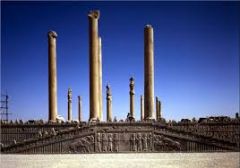
#30 Audience Hall (apadana) of Darius and Xerxes Persepolis, Iran Persian 520 - 465 B.C.E. ____________________ Content: The hall is part of a citadel that sits high on a plateau. The hall in now in ruins but the surrounding complex still includes an entrance gate to the citadel, ceremonial stairs and platform of the hall, and also a few of the massive columns that held up the hall roof. ___________________ Style: The audience hall stood on a platform led to by large, ceremonial staircases and able to house 10,000 standing guests. The hall had mud-brick walls and paved floors in stone or brick. The most noticeable feature, however, are the columns that once surrounded the hall. The columns had a total height of 64 feet, with tall bases, drums, and capitals. The entirety of the columns were fluted, and ringed with palm leaves on the bases. The capitals were decorated with volutes and topped with polished, painted, back-to-back animals and hybrid figures. There are griffins, bulls, lions, and composite man-headed bulls. The ceiling of the hall also included cedar beams as support. |
Context: The audience hall pictured provides important information about Persian art, architecture, influences, and ceremony. It is seen in ruins because the complex was razed by Alexander the Great, possibly as revenge for the Persian sack of the Acropolis. The Persians were, indeed, formidable enemies to Athens. The Persian Empire in the Achaemenid period spanned land from many areas and created the largest empire before Rome. The outer gateway for the complex was actually referred to as the "Gate of All Lands", referring to the harmonious way in which all the conquered lands of the Persian Empire lived. The inclusion of the column decoration was influenced by Assyrian, Egyptian, and Mesopotamic traditions and art. The man-headed bulls themselves are similar to the Neo-Assyrian lamassu in Iraq. The persepolis architecture of the hall must have wanted the strange beasts as decoration in order to convey the idea that the Persian king had enough power to captures those fierce animals and imprison them in his palace and have them serve him by holding the roof up. |

